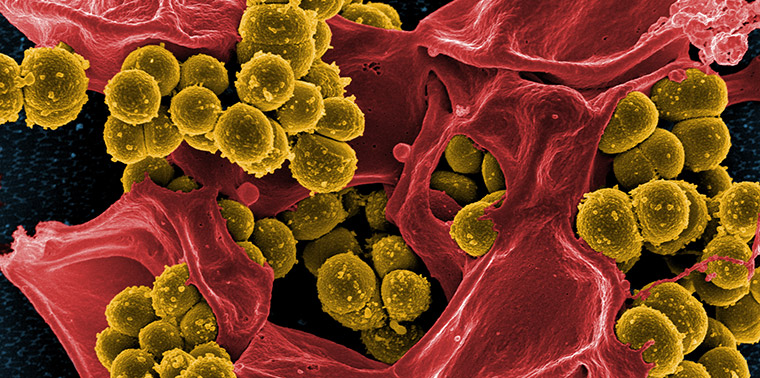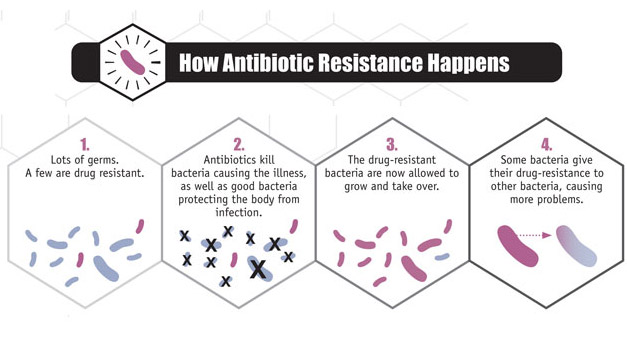July 6, 2017 — From the muddy bottoms of deep ocean trenches to Komodo dragon blood, scientists have scoured Earth’s remote corners in search of molecules that could yield the world’s next antibiotic. They hope to discover powerful new medicines against which bacteria have not yet evolved defenses. It’s a high-stakes pursuit. Disease-causing bacteria are becoming resistant to antibiotics more quickly than we’re discovering new ones.
That’s a big problem for humans. Infections that throughout the 20th century became easy to treat because of antibiotics have today become deadly. In the United States alone, more than 2 million people each year are infected with bacteria that can’t be killed by the drugs that were meant to stop them. At least 23,000 of those people will die as a result of their infections.
“[I]n the antibiotic ‘arms race’ against bacteria, humanity is rarely ahead,” wrote a team of researchers headed by microbiologist Gautam Dantas in a recent review article. Dantas, an associate professor at Washington University in St. Louis, is trying to change that.
We can no longer outrun antibiotic resistance by simply mining nature for new compounds, Dantas explains. He and others now are tackling the problem head on — by hunting for the genes that enable bacteria to become resistant to life-saving medications. Finding and decoding these genes may provide fresh clues about how antibiotic resistance emerges — and how to shut it down.
Unearthing the antibiotic resistome
Antibiotics are chemical substances that kill or slow the growth of bacteria. They are often thought of in terms of their medicinal properties that stop infections in humans, but many bacteria in the environment naturally produce chemicals with antibiotic properties, too.
In fact, some of our most important antibiotic discoveries have come from microorganisms in the environment. Scientists isolated penicillin, the world’s first antibiotic, from a type of mold in 1928. Other antibiotic discoveries — including streptomycin, the first medical cure for tuberculosis — came from soil bacteria. In the span of a generation, people stopped dying from injuries and illnesses such as pneumonia, scarlet fever and syphilis.
Scientists aren’t exactly sure why bacteria started making antibiotics in the first place, but they’ve been at it for a long time — probably since around the time bacteria emerged about 3.5 billion years ago. And since they were essentially creating their own poison with the antibiotics, the bacteria needed an antidote. So, over time, they evolved a suite of antibiotic resistance mechanisms.
Researchers have found genes encoding antibiotic resistance just about everywhere they’ve looked in the environment — on fossils scraped from the walls of subterranean caves or buried beneath feet of permafrost, even in the healthy gut microbes of people in a Yanomami Amerindian village who have never had contact with modern medicine.
“It’s an ancient feature of virtually every microbial ecosystem on the planet,” says Dantas. Scientists call this collection of resistance-conferring genes the antibiotic resistome.
Dantas and other researchers have spent the past decade cataloguing the resistomes of various environments — soil, farm animals, wastewater treatment plants, even the human gut. A stark picture is beginning to emerge — they’ve found genes encoding resistance to our most important antibiotic medicines lurking nearly everywhere they looked.
Growing Problem
If antibiotic resistance is ancient, why is it just becoming a problem for humans now?
“We’ve applied a very big stress to the natural system over the last couple of decades,” says Andrew Edwards, a microbiologist at Imperial College London.
Antibiotics are some of the most commonly prescribed medications on the planet. While there’s no doubt antibiotics can be life-saving, they’re also commonly misprescribed for minor ailments and illnesses that don’t respond to antibiotics, explains Edwards. In the United States alone, an estimated one in three antibiotic prescriptions isn’t necessary, according to the U.S. Centers for Disease Control and Prevention.
“Each time we use an antibiotic, it creates the opportunity for that adapt-or-die dichotomy.” — Gerry Wright
Then there’s the use of antibiotics in farm animals. Some poultry and other livestock receive antibiotics in their feed. Low doses of antibiotics help them grow bigger on less food, cutting the cost of production. A U.S. Food and Drug Administration report last year found that sales of medically important antibiotics for use in farm animals in the United States rose 26 percent between 2009 and 2015.
Bacteria are really good at improvising their way out of trouble — it’s how they’ve survived on the planet for 3 billion years, explains Gerry Wright, a microbiologist at McMaster University in Ontario, Canada. “Each time we use an antibiotic, it creates the opportunity for that adapt-or-die dichotomy,” he says. Because bacteria are so bountiful, and they reproduce so quickly, it doesn’t take long for some to develop mutations that confer resistance and then, in the presence of the antibiotics, to dominate populations.
All of this use has resulted in an increase of antibiotic resistance genes in non-disease causing bacteria found in the environment. A 2010 study from the Netherlands reported that genes conferring resistance to some tetracyclines, a class of antibiotics, were 15 times greater in soil bacteria by 2008 than the 1970s.
Doctors discovered resistance to penicillin soon after the drug was introduced, but antibiotic resistance wasn’t initially appreciated as a problem, because new antibiotics were being discovered at a quick pace throughout the 1950s and 1960s (what some call the golden age of antibiotics). However, the problem soon became obvious as the rate of discovery of new antibiotics began to slow through the second half of the twentieth century, Edwards explains.
ID’ing environmental reservoirs
Finding resistance genes to medically important drugs in bacteria from a manure pit or a ball field isn’t the same as finding them in disease-causing bacteria in the hospital. Each day we’re bathed in a sea of microbes, and most don’t make us sick.
But bacteria can swap DNA. Some bacteria send packets of DNA into their environment. Others pick up and incorporate those packets into their own genetic material. It’s called horizontal gene transfer, and it’s what many bacteria do instead of sex to spread their genes.
A benign soil-dwelling microbe could theoretically lend its antibiotic resistance genes to a human pathogen in this way. Researchers have long suspected that disease-causing microorganisms could dip into environmental pools of antibiotic resistance, but experts weren’t sure whether this was actually happening at any meaningful rate.
Historically, humans have taken a reactive approach to antibiotic resistance — waiting to act until some superbug shows up in the clinic. Dantas and others now are taking a proactive approach.
In 2012, Dantas and colleagues showed for the first time that it was. They found soil microbes that shared a set of antibiotic resistance genes with human pathogens. Exchange of resistance genes between soil and clinic established soil as a key player in the network of pathogenic resistance, explains Dantas, though their research did not show the direction of the transfer — whether the genes moved from soil to pathogen or pathogen to soil.
Morten Sommer, a professor of biosustainability at the Technical University of Denmark, now is trying to understand which environmental reservoirs pose the most risk to human medicine.
“We want to know how and where that transfer to human pathogens is most likely to occur so we might be able to prevent the spread of resistance genes out of those environments,” says Sommer. He doesn’t have the answers yet, but he’s probing the antibiotic resistomes of soil, farm animals, wastewater treatment facilities and even the “good” bacteria of the human gut.
Finding a Solution
Armed with a greater knowledge of the antibiotic resistome, scientists can devise new ways to counteract resistance to the drugs we already have and the antibiotics of the future.
Historically, humans have taken a reactive approach to antibiotic resistance — waiting to act until some superbug shows up in the clinic. Dantas and others now are taking a proactive approach. In May, Dantas along with several other Washington University researchers discovered a group of compounds produced by bacteria that could block resistance to tetracyclines by “gunking up” the cellular machinery some bacteria use to make the drugs ineffective. They’re now exploring whether these resistance-blocking compounds could be given together with existing antibiotics to help preserve their efficacy.
It’s just one example. Other researchers are using the resistome to come up with new combinations of antibiotics that could help slow the spread of multi-drug resistance, where bacteria are resistant to more than one antibiotic. In the antibiotic discovery pipeline, some new compounds make better candidates than others, but researchers often can’t weed out the duds until resistance shows up in the testing phase — a time-consuming and costly process. Understanding the likelihood of a rare genetic swap from one environment to another may help scientists save time and resources by predicting earlier which new compounds may be more or less susceptible to widespread resistance.
Dantas is hopeful about the possibilities, though none of it really matters if we don’t curtail our current antibiotic use, he points out. Antibiotic resistance is a fact of nature. It’s not going away unless bacteria go away (in which case we’d be gone too). There are steps we can take to stay ahead of it or even slow it, but “we have to protect the armamentarium if we want that shot,” he says. ![]()
Ensia shares solutions-focused stories free of charge through our online magazine and partner media. That means audiences around the world have ready access to stories that can — and do — help them shape a better future. If you value our work, please show your support today.
Yes, I'll support Ensia!


https://www.youtube.com/watch?v=Krk2CoE2FPs